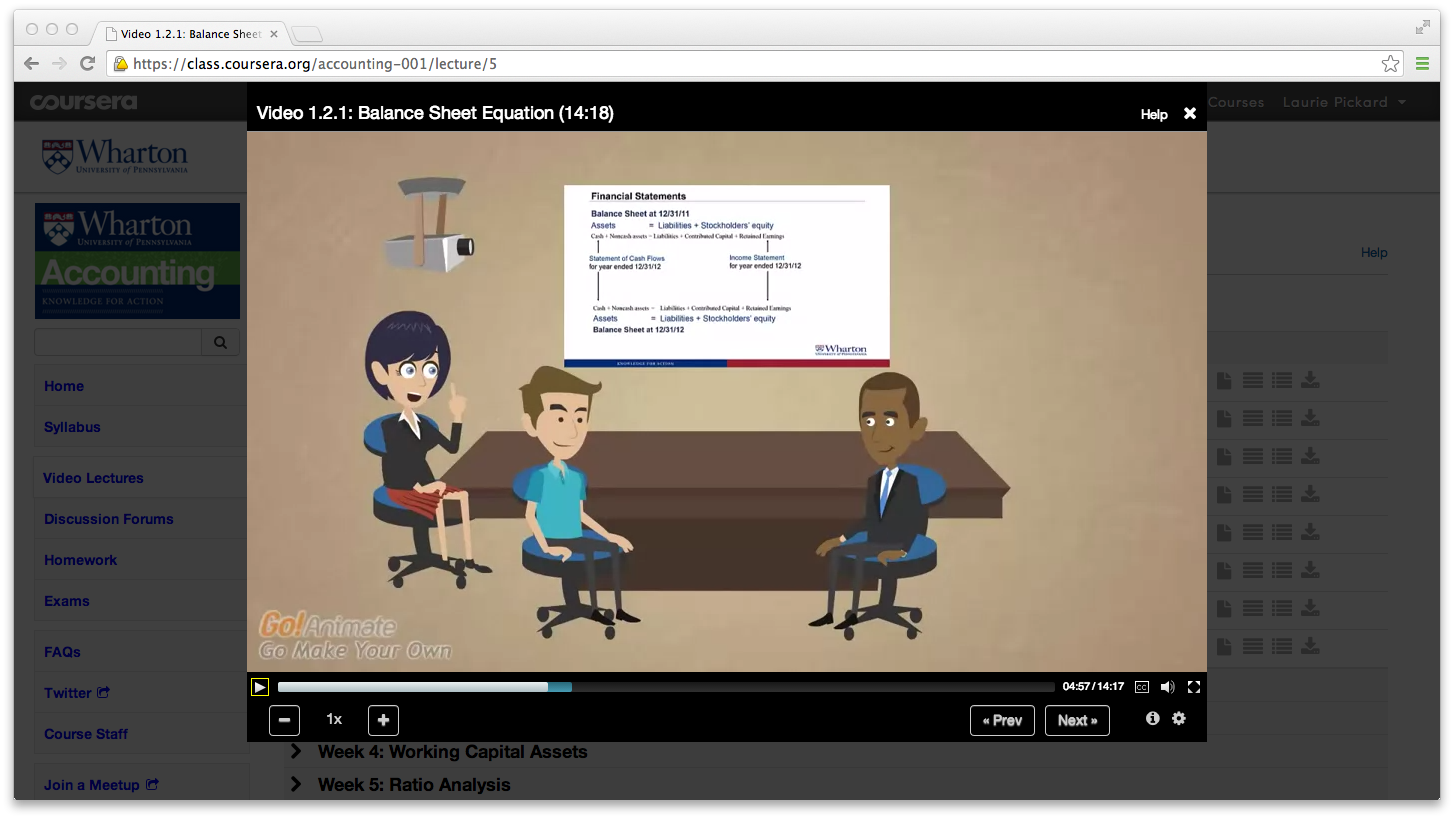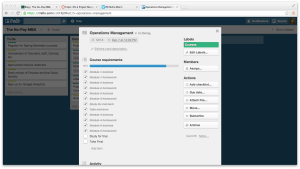by Laurie Pickard | Dec 8, 2013 | Courses, Platforms, and Profs, Thoughts on Higher Ed and Life
A recent Huffington Post blog entry asks the question, how do you define a MOOC? For example, how big does a course have to be to be considered “massive”? Does a course have to be completely free to be considered “open”? And what exactly is a “course” anyway? For example, does a podcasted lecture count as a course?
I am not overly concerned about whether my coursework falls into the MOOC genre. Rather, what matters to me is that my courses be free or nearly free, that they cover subjects that are MBA-relevant, and that they allow me the opportunity achieve mastery in a subject area.
I’ve taken several different types of free courses since I started this project. My first was a class on coffee price risk management offered by the World Bank. It wasn’t technically a MOOC because it wasn’t open – I needed a CD with an access code to take it – but it was similar to a MOOC in that I was responsible for supplying the motivation to get through the course, and there was no teacher to help me out if I got stuck. I’ve since taken courses on iTunesU, Coursera, Canvas Network, and Open Yale.
Based on that diversity of coursework, here are my criteria for what makes a good MOOC. (Bear in mind that I’m using the term “MOOC” loosely.)
- The course should be intended for an online audience.
It has been much easier for me to learn in courses that are actually intended for an audience that is not physically in the same room as the teacher. While it’s cool to be able to listen in on the regular live classes of top professors, it’s difficult to truly follow along when you’re missing so much of the face-to-face interaction of the classroom. This turns out not to be a problem in a course where the professor is speaking to online students.
2. A course that follows a defined schedule is better than a self-paced course.
I’ve taken courses with a set schedule and deadlines for homework assignments and exams. These courses are much easier to finish than those that require the student to pace themselves for the whole course. That said, flexibility is also a virtue. It’s best when the course offers a window of about two weeks to complete an assignment. That way a heavy week at work won’t totally throw you off track.
3. A simple layout is best.
I’ve taken most of my courses so far on Coursera, primarily because the offerings are so much better than any competitor’s. But now that I’ve started a course on a another site – Canvas Network – I must say I have a strong preference for Coursera’s layout. The side bar on the course home page shows me everything I want to see – links to video lectures, homework assignments, the course syllabus, and the discussion forum all in one place. Canvas walks you through the course, from one module to the next, with the quizzes and discussion forums threaded through. Unfortunately, this system makes it much more complicated to find anything. I recently discovered a series of homework assignments I had missed because I hadn’t correctly navigated the course modules.
4. Multiple forms of information delivery can be effective.
Coursera courses are based around video lectures, often with Power Point slide shows worked through. Canvas uses more text pages, with some live (and later archived) video discussions. The World Bank coffee course I took was almost all text. Some courses have included links to external sites – whether to provide supplemental information, real-world examples, or practice with concepts. All of these forms of delivering information are effective. My Accounting teacher went above and beyond by including animated virtual students in his video lectures, but that’s really not necessary.

5. Don’t just give an overview; go into detail.
I don’t know if it’s that they didn’t have the time to do a thorough job or if they think online students won’t get it, but some of my courses have been too superficial. The main culprits here are International Organizations Management and, as I’m coming to find out, Project Management Skills for All Careers. It really irks me when the professors allude to a skill set that is necessary in the subject they are teaching, then gloss over the technicalities of employing that skill set. For example, my Project Management class recently had a module explaining the importance of making the business case for a new project, but didn’t go into any specifics about how to do the analysis, or how to present the results!
6. Make the homework difficult.
My biggest pet peeve is when instructors assign posting to the discussion forum as homework. The forum gets so crowded with useless posts. “I agree with what So-and-so said.” Or, “Thank you, professor, for an interesting lecture.” You scroll through hundreds of these comments, only to post your own superfluous message and get “credit” for it. Another pet peeve is easy quizzes. If I can ace the quiz without listening to the lecture, it needs to be more difficult. Problem sets are the best kind of homework. Preferably difficult ones. Kudos to my professors of Accounting and Operations Management for making good problem sets and hard quizzes.
In summary, a good MOOC is one that is simple to navigate, that works within the limitations of an online platform, and that is challenging enough to be rewarding.
In other words, give me what I need to succeed, then make me work for it.
My Accounting course is a great example in this regard. Sure, it was difficult, but in the end almost 10,000 of us will be receiving a Statement of Accomplishment. And for this course, I’m truly proud to have earned it.
by Laurie Pickard | Nov 24, 2013 | Courses, Platforms, and Profs
As first semester comes to a close, I will soon be enrolled in only one course. New Models of Business in Society ended a while back, International Organizations Management also wrapped up several weeks ago, and I’m preparing for finals in my two Wharton courses – Operations Management and Accounting. Until Spring Semester starts, my only course will be Project Management Skills for All Careers, through Canvas Network. It’s good timing for a lightened course load, since I just started a new job – hooray! (More on that in a future post.)
Project management is kind of my thing. Even though I haven’t studied it formally until now, project management is the bread and butter of my professional life. I am the type of person who gets truly excited about a well-designed spreadsheet, and creating a color-coded calendar is the type of thing I might do for fun, so I was a bit skeptical that this intro course geared towards accidental project managers would have anything to offer me.
I’m pleasantly surprised that already in the first two modules of my Canvas course we have covered some material that I have found interesting and enlightening.
The Difference Between Project Management and Operations Management
First, I was pleased to get a definition for project management as opposed to other kinds of management. To paraphrase from the textbook we are using for the course - a digital book with the same name as the course itself:
A project is temporary in nature and geared towards producing a unique outcome. It ends once it has met its goals and objectives or is cancelled if those goals and objectives cannot be met.
Managing a project is quite different from managing an ongoing process. The latter was the topic of my course in Operations Management, which was geared towards finding efficiencies in processes that are repeated again and again, over an indefinite period of time. In contrast, a project happens only once, so much of it is created new and is specific to the task at hand.
The Three Pillars of Project Management
Second, the course offered a helpful set of key considerations in any project, which are referred to as the three pillars of project management. These are:
- Cost,
- Schedule, and
- Scope/quality.
Inherent tradeoffs exist among these three pillars, as exemplified in this sign that was printed in our textbook, said to have come from an auto repair shop:
We do GOOD, CHEAP, and QUICK work.
You can have any two but not all three.
GOOD QUICK work won’t be CHEAP.
GOOD CHEAP work won’t be QUICK.
QUICK CHEAP work won’t be GOOD.
Visual Project Management
Third, and best of all, the course jumped right into practical techniques for managing projects. The method they started with is called visual project management. Imagine a white board with cards that represent tasks that must be completed as part of the project. The cards are organized into three columns: To Do, Doing, and Done. Several free web-based software programs offer virtual whiteboards and cards. I have started using one called Trello, and I am absolutely in love with it.
Here, you can see how I am organizing the No-Pay MBA. Cards with a green label are for courses, and those with a yellow label are for blog-related items.

If you click on any of these cards, the back of the card offers many other tools including checklists, deadlines, color-coded labels, email notifications, etc.

I’m excited to see where Project Management for All Careers goes next, but even if I don’t get anything else out of the course, I’ve gotten my money’s worth – and I’d feel the same even if the course weren’t free.
by Laurie Pickard | Nov 15, 2013 | MOOC MBA Design, Most popular posts
“A dollar today is worth more than a dollar tomorrow.” Most of us have probably heard someone say something to this effect. We understand intuitively that a dollar in hand is preferable to a dollar some future date. But why is this true?
Turns out it is possible to calculate exactly how much more a dollar today is worth than a dollar tomorrow, five years from now, or twenty years from now. The discount rate, otherwise known as the rate of inflation, can be used to take today’s dollar and translate it into future dollars – or to figure out how much a future amount of cash would be worth today.
This type of analysis is a powerful tool for determining whether a given investment is a good idea or not. To do this, you simply compare the amount of the investment to the predicted future cash flows from the investment, discounted back over the life of the project. Simple. This analysis is known as the net present value (NPV) of the investment - in other words, how much the whole investment is worth in today’s dollars.
What is the value of The No-Pay MBA? Or of any MBA for that matter? Answering this question is fairly simple – it just requires making a few assumptions.
First, let’s assume that the No-Pay MBA is not in fact completely free. Let’s say I end up spending around $1000 up front. This covers what I’m paying for internet access, web hosting, wear and tear on my computer, business books I’m buying, and other expenses.
Second, I’m assuming that there is no opportunity cost of The No-Pay MBA. It’s not taking time away from other employment, it’s not keeping me from doing any kind of paying work, and there is nothing else I could be doing with the time I spend working on my MBA that would result in monetary compensation.
Third, I’m assuming that I’ll be able to leverage this project to get a higher salary in the future. Let’s say as a result of having done the No-Pay MBA I’m able to earn $5,000 additional income per year starting a year after I finish.
Finally, I’m assuming a 3% interest rate.
The calculation can be done in Excel, and it looks something like this:
| Year |
Additional income or expense |
NPV |
|
0
|
$(1,000.00)
|
$(1,000.00)
|
|
1
|
$-
|
$-
|
|
2
|
$-
|
$-
|
|
3
|
$5,000.00
|
$4,575.71
|
|
4
|
$5,000.00
|
$4,442.44
|
|
5
|
$5,000.00
|
$4,313.04
|
|
6
|
$5,000.00
|
$4,187.42
|
|
7
|
$5,000.00
|
$4,065.46
|
|
8
|
$5,000.00
|
$3,947.05
|
|
9
|
$5,000.00
|
$3,832.08
|
|
10
|
$5,000.00
|
$3,720.47
|
|
11
|
$5,000.00
|
$3,612.11
|
|
12
|
$5,000.00
|
$3,506.90
|
|
13
|
$5,000.00
|
$3,404.76
|
|
14
|
$5,000.00
|
$3,305.59
|
|
15
|
$5,000.00
|
$3,209.31
|
|
16
|
$5,000.00
|
$3,115.83
|
|
17
|
$5,000.00
|
$3,025.08
|
|
18
|
$5,000.00
|
$2,936.97
|
|
19
|
$5,000.00
|
$2,851.43
|
|
20
|
$5,000.00
|
$2,768.38
|
|
21
|
$5,000.00
|
$2,687.75
|
|
22
|
$5,000.00
|
$2,609.46
|
|
NPV of No-Pay MBA |
$69,117.23
|
After adding up the present value of each years’ worth of additional salary, it turns out that after 22 years, the No-Pay MBA is worth $69,117.23!!!! Wow!
But let’s say I can’t get $5,000 additional salary each year. Let’s say I can only get $2,000 additional salary. In that case, the No-Pay MBA is only worth $25,216.61. That’s still a lot given how little it’s costing me.
Or what if I can only get a one-time salary bump of $3,000 some time in the middle or my career – let’s say after 7 years. In that case, the No-Pay MBA is only worth $1,439.
Going through these calculations for different assumptions is called sensitivity analysis. I’ve played around with my assumptions, but no matter how you slice it, the No-Pay MBA is a good value. In corporate finance, any investment with an NPV that is a positive number is considered a good investment.
By contrast, a regular business degree comes with a much higher price tag, as well as a much greater opportunity cost. I’ve also estimated how much money I would have to earn each year in order to justify the expense of a traditional MBA. Assuming a total cost of $250,000 (including the opportunity cost of lost years of salary), I would have to earn $15,500 in additional income every year just to break even. I don’t mean to bad mouth traditional MBA programs – and it isn’t actually very far fetched that someone with that degree could earn an additional $15,000 per year, or even a lot more than that. But given my industry and the fact that I’m the trailing spouse of a foreign service officer, the free option seems like a much safer bet.
by Laurie Pickard | Oct 31, 2013 | Courses, Platforms, and Profs, Thoughts on Higher Ed and Life
My most disappointing course this semester was International Organizations Management. I chose the course because I work in this field and was curious what the instructors would present. The course was taught by a group of professors from the University of Geneva, all of whom are on the faculty of that university’s international MBA program. As I’ve mentioned previously, most of the jobs in international development, and I would imagine in international organizations more generally, are management jobs. However, our training is mostly theoretical, so one must learn the practical skills of management while on the job. I was hoping that this class would cover some of these skills, especially since the recommended background for the course was “Graduate students of international relations/business management/international law and/or professionals with a few years of relevant work experience.”
I was sorely disappointed – yet another class longer on theory than practice.
I was hoping for best practices related to the work that I do, for example:
- Managing a project budget
- Conducting and participating in meetings
- Creating a work plan and project timeline
- Crafting a monitoring and evaluation plan, including setting targets and choosing indicators
- How to design a public private partnership (the course did touch on this, but didn’t get into specifics)
Alas, what I got instead was more an overview and history of the UN system than any practical tools for operating in the international arena (in which, incidentally, the UN is only one player, and not necessarily the most important player at that!).
Interestingly, the one module of the course that I really enjoyed was the one on marketing, not a topic in which I had any prior interest. What I liked about the module was that it spoke about particular techniques for making a marketing plan, including specific questions that an organization needs to answer in order to make a strong plan. The course also made me realize that I have had the wrong understanding of marketing, probably because most international organizations approach marketing as though it were of secondary importance – an afterthought.
The following graphic shows the place of marketing in most international organizations.
Marketing falls below communications, which itself is a third-tier category. Contrast that with the position of marketing in the private sector.
In a private sector company, marketing is directly under the CEO and is responsible not just for PR and promotion but is integrally involved with crafting the overall strategy for the company and in building its identity.
Even though I didn’t learn much in International Organizations Management that I can apply on the job, I did benefit from the course in that it piqued my interest in marketing - one of the topics for next semester. So in the end, I’m glad I stuck it out.
by Laurie Pickard | Oct 24, 2013 | Courses, Platforms, and Profs, Thoughts on Higher Ed and Life
Operations Management is one of those classes that causes you to see your whole world differently. The class is more conceptual than mathematical – though there is some math involved – and we’ve covered such concepts as The 4 Dimensions of Performance, The Bottleneck in a Production Line, Inventory Turns, Throughput, and Capacity. Now I’m looking at every multi-step process in my life with new eyes. I even found The Seven Sources of Waste – and hence the opportunities for improved efficiency – in the Indian vegetable curry and garlic naan I made for dinner yesterday evening.
- Overproduction. There are only two of us, but my naan recipe produced 12 fluffy pieces of bread.
- Transportation. The spice packet I used to flavor my curry was produced in India. I purchased it in St. Louis, MO and packed it in my shipment to Rwanda, where my husband and I are stationed. Talk about transportation! If only I could find Indian spice packets locally.
- Re-work. My inexperienced hands took multiple attempts to form round naan. In the end, they were still uneven – but delicious.
- Over-processing. I budgeted too much time for the curry, and too little for the bread, so the curry ended up cooking longer than it needed to. No effect on the taste, but a small amount of wasted electricity.
- Unnecessary motion. Why are cutting boards always too small? Seems like I’m constantly going back and forth between the cutting board and the pot on the stove.
- Inventory. All those chopped veggies ready to go into the pot. In Operations Management, “inventory” is the item that is going through the process – in this case vegetables going through a process of becoming curry.
- Waiting– for the web page with the recipe to load. Could Rwanda’s internet be any slower?








